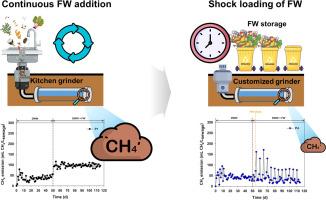减少下水道管道甲烷排放的食物垃圾冲击
IF 10.9
1区 环境科学与生态学
Q1 ENGINEERING, ENVIRONMENTAL
引用次数: 0
摘要
下水道管道虽然对城市卫生至关重要,但也是甲烷(CH4)排放的重要来源,特别是当食物垃圾(FW)通过厨房处理器进入时。本研究探索了一种新的缓解方法“FW冲击”的灵感来自已知的冲击负荷破坏厌氧消化。实验运行了5条实验室规模的重力下水道管道(P1 - p5),最初只加入生活污水(DWW),随后加入FW: P1连续加入,FW积累2 - 7天后间歇性加入P2-P5。P1连续添加FW导致CH4持续增加(从44.6 mL / l污水增加到98.0 mL / l污水),而FW冲击在冲击日引起峰值排放,随后迅速下降。在P4(休克5天)观察到最大的减少(61.8%)。P4的pH值降至6.4,而P1的pH值为7.8,这有助于抑制产甲烷。微生物学和酶学分析证实,FW休克诱导的低pH条件下醋酸破酯产甲烷菌受到抑制。本文章由计算机程序翻译,如有差异,请以英文原文为准。

Food waste shock for reducing methane emissions from sewer pipelines
Sewer pipelines, while essential for urban sanitation, are significant sources of methane (CH4) emissions, especially when food waste (FW) is introduced via kitchen disposers. This study explores a novel mitigation method “FW shock” inspired by shock loading known to disrupt anaerobic digestion. Five lab-scale gravity sewer pipelines (P1–P5) were operated, initially with only domestic wastewater (DWW), followed by FW addition: continuously in P1 and intermittently in P2–P5 after accumulating FW for 2 to 7 days. Continuous FW addition in P1 led to a sustained CH4 increase (from 44.6 to 98.0 mL CH4/Lsewage), while FW shocks induced peak emissions on the shock day, followed by rapid declines. The greatest reduction (61.8 %) was observed in P4 (5-day shock). pH dropped to ∼6.4 in P4, compared to >7.8 in P1, contributing to methanogenic inhibition. Microbial and enzymatic analyses confirmed suppression of acetoclastic methanogens under low pH conditions induced by FW shock.
求助全文
通过发布文献求助,成功后即可免费获取论文全文。
去求助
来源期刊

Resources Conservation and Recycling
环境科学-工程:环境
CiteScore
22.90
自引率
6.10%
发文量
625
审稿时长
23 days
期刊介绍:
The journal Resources, Conservation & Recycling welcomes contributions from research, which consider sustainable management and conservation of resources. The journal prioritizes understanding the transformation processes crucial for transitioning toward more sustainable production and consumption systems. It highlights technological, economic, institutional, and policy aspects related to specific resource management practices such as conservation, recycling, and resource substitution, as well as broader strategies like improving resource productivity and restructuring production and consumption patterns.
Contributions may address regional, national, or international scales and can range from individual resources or technologies to entire sectors or systems. Authors are encouraged to explore scientific and methodological issues alongside practical, environmental, and economic implications. However, manuscripts focusing solely on laboratory experiments without discussing their broader implications will not be considered for publication in the journal.
 求助内容:
求助内容: 应助结果提醒方式:
应助结果提醒方式:


